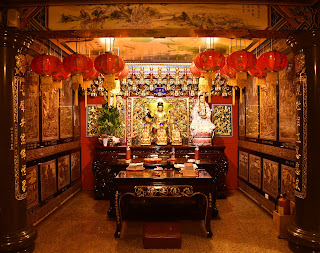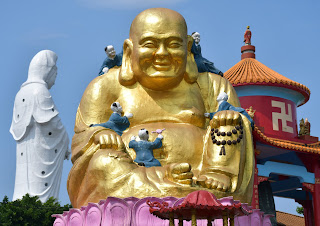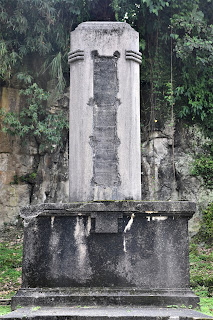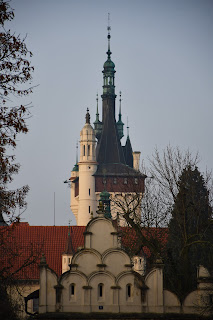Keelung
As soon as
I cancelled my flight to California, I started to compile a mental list of
places I might want to see in order to make up for my scrapped travel plans. I
have not yet been to Sun Moon Lake, Jiufen, or the Southern Branch of the National
Palace Museum in Chiayi, all of them places enthusiastically recommended to
foreign travellers. Of course, the Penghu Archipelago, the Matsu Islands, and
Kinmen are all worth seeing as well, but with the current epidemic, I think it
best to avoid air and water traffic if at all possible.
Another
place I had not yet visited, at least until this weekend, was Keelung, famous
for being one of the first Taiwanese locales colonised by the Europeans in the
17th century, and for having served as one of Taiwan’s major ports
ever since. Since Keelung is but a short train ride from Taipei, I woke up at
seven, made may way over to the train station in a leisurely manner, and only
bought my ticket once I arrived there. I got to Keelung before ten o’clock.
What
immediately struck me about Keelung was the smell of the city. I am not quite
sure what it was, but it left me with the impression that Keelung is not as
clean and modern of a city as Taipei, or even Tainan, for that matter
(Gaoxiong, perhaps, could rival Jilong in that it had its fair share of strange
smells too). However, there is nothing better to exorcise bad smells than a
liberal amount of incense, which is lucky since my first steps led to the most
important temples in the city.
I began my
sightseeing tour at the Qing’an Temple, dedicated to the goddess Mazu. I arrived just at the time of
worship: people were bustling in and out carrying sticks of incense, and a
chorus of women in black sang while standing side-by-side in front of the
central idols. The focal point of the entire ceremony was the priest, who, himself
clad in black robes with a black and red surplice, kneeled in front of the
offerings in the middle of the courtyard while reciting prayers. Every now and
then, he was approached by a visitor with an entreaty, upon listening to which
he would, without any change in pace, consult the higher powers and deliver
heaven’s answer to the question asked. He did so by holding the scroll out to his
left and then throwing the wooden tablets on top of it into the air. The way
these blocks landed on the ground (either both face up, both face down, or one
face up and one face down) gave either a “yes” or “no” answer to the
supplicant’s question.
Inside the Qing'an Temple
A priest reading a prayer scroll
A view of the inner court from the second floor balcony
The same priest from a different angle
The priest holding out the tablets before throwing them into the air
Closest to the viewer is the supplicant. The priest kneeling in front of the offerings relays her question to the heavens. In front of the idols stands a group of women singing songs of worship.
After
visiting another temple, called Dianji, I crossed the river in search of
Zhongzheng Park. What I found was the city’s Martyrs’ Shrine, apparently
serving as the entrance to the park, from which I continued up the hill before
arriving at a temple that was apparently closed to the public. Figuring that
the temple was not important anyway, I started looking for a way to continue to
my actual goal, Keelung’s iconic twenty-two-metre-tall Guanyin statue. I had
the luck of being approached by an elderly man wearing a USS Navy hat, who,
after asking me where I was from and evidently not recognising the name,
proudly announced that he was a US citizen who had worked at the Florida
Disneyland for forty years. He told me I was very handsome (a compliment I
appear to receive only in East Asia), and pointed me in the right direction.
I often
read in the accounts of nineteenth century missionaries very negative
portrayals of Chinese temples. The preachers frequently complained of what they
called superstitions (the fortune telling I witnessed at Qing’an Temple being
one example), flashy displays, and various vices like gambling. These accounts
must, of course, be taken with a grain of salt, but I could see where the
missionaries were coming from when I arrived at the top of he mountain and saw,
before the statue and temple, families playing arcade games and children riding
buggy cars as though the place were an amusement park. Admittedly, given the
gaudiness of some of the statues, the decorations did not do much to dispel that
atmosphere.
A house that most definitely does not serve as a windmill
Dianji Temple
An idol at Dianji Temple
The Hollywood-like sign appears to be a truly aspirational one
I am not sure what this building is, but it caught my eye
The same building from the platform in front of the Martyrs' Shrine
Rhododendrons have been in bloom for several weeks
Keelung skyscraper behind a rhododendron bush
Keelung Zhupu Altar standing over the city
Zhupu Altar
A golden Budai with Keelung's Guanyin statue in the background
Another view of the same
After
consulting a bus schedule that put the arrival of the next vehicle twenty
minutes in the future, I decided not to wait in the baking sun and instead
headed to my next destination on foot. Despite fearing for half the journey
that I had gotten lost, I persisted, and surely enough, I arrived at the
entrance to the Ershawan Fortress sooner than I saw any bus do so. Its rusty
nineteenth century cannons, juxtaposed against beautiful tropical butterflies
fluttering through the air, made for a quite surreal spectacle, and the scene’s
paradoxical ambience was completed with mechanical noises coming from the
industrial shipyard below the mountain.
By
following the trails, I saw most of the fortress, but was somehow spat out into
a forest path, which led uncertainly in directions I did not expect it to.
Without really knowing how, I ended up at a four faced, Thai-style Phra Phrom, around whose octagonal pedestal sat meditating visitors. Finding the
statue on my phone (which for my whole trip did a horrible job of determining
my location), I was able to navigate my way down the hill, in the direction of
my next stop.
Wild flowers at the Ershawan Fort
A cannon
Keelung's noisy port as seen from the Ershawan Fort
A fenced off path down to the harbour
The lower gate of Ershawan Fort
Another view of Ershawan's gate
The Phra Phrom of Keelung
The octagonal pedestal of the four-faced god
A monument to the Japanese Prince Kitashirakawa Yoshihisa
My
destination was the French cemetery in Keelung, a truly unique sight whose
uniqueness was somewhat belied by the fact that I was the only visitor there.
The cemetery, nestled under the windows of some shabby-looking apartment
buildings, serves as the final resting place of French soldiers deceased during
the Keelung Campaign of 1884-5 (part of the Sino-French War). I write
“deceased” rather than “killed” since most of the soldiers died not as the
result of armed conflict but from tropical diseases.
An obelisk commemorating the French expedition in Keelung
The inscription on the obelisk
The sign explains that two of the commanding officers were originally buried at Penghu and were later exhumed and transferred here
A grave
More pillars
Another obelisk
Another obelisk inscription
A closer view of one of the pillars
To my luck,
dozens of taxis kept coursing through the roads outside the cemetery, so there
was no difficulty in hailing one and continuing to the final place I wanted to
visit in Keelung: Heping Island Park.
To be
honest, I forgot why I had wanted to visit the park in the first place, but its
singularly impressive sights jogged my memory. The island (connected to the
Taiwanese mainland by a bridge) is home to a Martian landscape full of
outlandish geological features that have been worn down into improbable shapes
by millions of years of erosion. Some look like doorknobs, some – so say the
signs – like pig trotters, and some – again, borrowing the metaphor – like a
field of human heads. There is even a rock with a little cave in it, said to
have been the refuge of a few fearful Dutchmen during Koxinga’s takeover. None
of my sources really talk about what was happening in north Taiwan while
Koxinga was besieging Fort Zeelandia, so that tall tale is something that I
might want to check up on should I ever make a deeper study of VOC documents
than those translated into English by Campbell and Blussé.
The picturesque scenery at Heping Island Park
The so-called "island within an island"
Keelung Islet emerging behind the rock formations of Heping Island Park
The natural beauty of Heping Island Park
Another view of Keelung Islet
A tribute to the Ryukyuan fishermen killed during the 2/28 incident
An eastward view across Heping Island Park
The Heping Island Park gazebo
Strange rock formation
Even stranger knob-like rocks
A closer inspection of the beige rock on the right truly does reveal at least one cave
Another view of Keelung Islet
More views of the strange rocks of Heping Island Park
Another view of the gazebo
More knobs
A lighthouse and mountains in the distance
And yet more knobs
A serene scene of a lighthouse and blue mountains
Keelung Islet rising over hundreds of rocks resembling heads
Anyway, by
the end of my visit to the park, I felt rather tired and ready to return to
Taipei. I took a taxi back to the Guanyin statue, hoping that the sun would not
be right behind it and that I would not be blinded trying to take a look. It
was a little cloudier than in the morning, so I half-succeeded. I also made
another stop by the Qing’an Temple, as I hoped to see its idols which had been
blocked from my view by the choir of older Taiwanese women. To my surprise,
they were still singing. I had no choice at that point but to head back to head
back.
The Bodhisattva Guanyin
More rhododenrons
An azalea - all right, I have clearly been guessing up until here, but I am pretty sure about this one
The goddess Mazu





























































Comments
Post a Comment